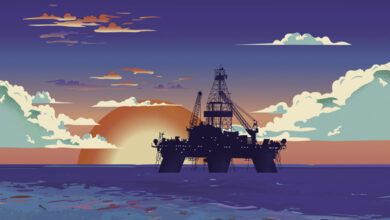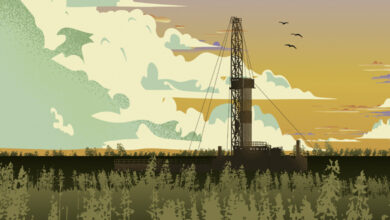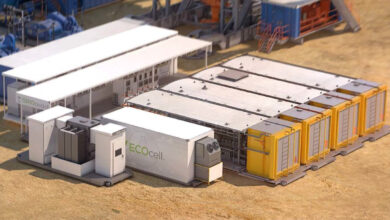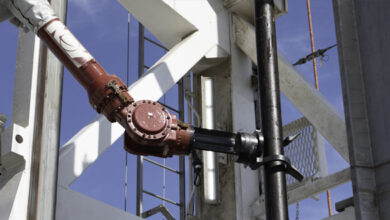By Diane Langley, editorial coordinator
All signs point to drilling activity increasing slightly in the Middle East oil and gas province. While activity was down in 2009 and 2010, contractors, operators and a rig yard in this region are reporting increases in activity and demand for drilling units. Rigs in the 1,500-hp to 2,000-hp range with top drives and increased personnel capacity are being favored.
“We’re seeing a huge rise in refurbishment activity,” said Lamprell marketing manager Ian Anderson. Lamprell, a major ship and rig builder in the Middle East that is bidding to take over neighboring Maritime Industrial Services, reports that Saudi Arabia and Iraq are taking up a lot of previously stacked rigs, and the former is bringing in new high-spec rigs as well.
Lamprell recently built two LeTourneau 116E units for Seadrill and is building two jackups for National Drilling Company and two land rigs for Weatherford Drilling International. It’s also refurbishing one rig for Dubai-based Momentum.
Nabors Arabia
“We’ve already seen quite a dramatic change in the drilling climate this year; Saudi Aramco is ramping up by 25% to 30% in drilling activity,” Larry Perras, general manager for Nabors Arabia, said. “They’re going from 90 to 118 rigs, we understand, and already we’ve seen most of those incremental contracts being awarded.”
Iraq also continues to demand more rigs, as does Jordan, Abu Dhabi and Oman, he said. “The whole Middle East region, with the exception of Libya, is trying to pick up the slack. Unrest in Libya has really affected the whole region in that Aramco is turning up operations to meet the demand shortfall. The company is needing to create infrastructure in some of its fields, so that’s created a major change in the number of rigs they need,” Mr Perras said.
He believes that activity will be greatest for Nabors Arabia this year in Saudi Arabia, where the company expects to run between 27 and 31 land rigs, followed by Iraq and Oman. There’s a lot of gas development going on, but the upturn in the market is mostly targeted for oil, according to Mr Perras.
“There’s a big increase we’ve just seen in March for oil rigs. One oilfield project in Saudi currently has eight rigs working, and they want to go up to 23,” he said. More workover rigs for oil projects have also been picked up.
Demand for rigs in Iraq is also high, he continued, although the lack of infrastructure there is having a slowing effect. “As the infrastructure gets in place, I think the rig count will go up significantly.”
And in Oman, the government is attempting to create more jobs for their citizens. “They’ve said they want more drilling,” Mr Perras said.
Nabors is looking at a 72% rig utilization in Saudi Arabia, but “with mobilization of some of the rigs from Saudi into Iraq and incremental rigs going back to work, we will be going to 91% utilization,” Mr Perras said.
Utilization in Iraq is 100% because rigs are sent there only against contract, and utilization in Oman is above 85%, he said. The company also has four rigs in Yemen, one operating and three on standby.
“Our current commitments to clients are going to pretty much take up the stacked rigs that we have, so the company purchased the newly built rigs so we can meet market demand quicker,” Mr Perras said.
In Saudi Arabia, Mr Perras reports that new contract specifications are requiring a huge capital investment on the part of drilling contractors. “For example, they’re asking for API-monogrammed BOPs. There will probably be hundreds of millions of dollars spent on well control equipment to get up to that specification,” he said. “Then there are 7,500-psi mud systems; we’ve upgraded several rigs for that now.”
Offshore, Nabors Arabia had four jackups working, although two are now in the shipyard being retrofitted. “We’ll finish the year with four jackups working in Saudi,” Mr Perras said.
Rowan Companies

Rowan Companies’ Middle East manager Kelly McHenry reported that the region has witnessed an increase in drilling activity starting with Q4 2010. “We’re expecting the increase to continue, he said. “Our utilization is running about 70%. That hasn’t really changed from last year, but it will be increasing through this year. Dayrates are holding steady. We’re predicting that they will go higher.”
“As far as drilling plans and operations, unrest in the region has not affected us at all,” Mr McHenry said. “Just like every company, it has brought our awareness up. We did evacuate in Egypt. We and a lot of companies have gone back in. From a personnel perspective, we’re keeping a close watch on the situation in Bahrain.”
Offshore Saudi Arabia and Qatar are where Rowan is seeing the most activity now and expects to see the most drilling activity in the near future. While gas has been the predominant type of wells being drilled, there has been an increase in oil drilling as well. Mr McHenry said Rowan is contracting out rigs ranging from units with 10k BOPs and 1.2 million lbs of hookload to 15k BOPs with 2.5 million lbs of hookload.
“We are increasing personnel-on-board accommodations along with skidding capacities,” he said. “These are the big demands we’re seeing on tenders right now.”
Three of Rowan’s Marathon LeTourneau 116 cantilever jackups – the Rowan Middletown, the Arch Rowan and the Charles Rowan – have been completely refurbished and steel has been replaced. These rigs are ready to come out of the yard in the United Arab Emirates.
The J.P. Bussell, a Tarzan-class rig, recently finished a contract in Egypt and is hot stacked. Three other Tarzan-class rigs working in Saudi Arabia – the Scooter Yeargain, the Hank Boswell and the Bob Keller – are coming to the end of their contracts.
In Qatar, three LeTourneau 116 rigs are in operation, though contracts are finishing up on a time frame of as little as two months to Q3 this year. Rowan has three LeTourneau 116 cantilever rigs working in the United Arab Emirates, and the Bob Palmer, a Gorilla-class rig, is undergoing modifications in a Bahrain shipyard and being prepared for a contract in Saudi Arabia.
According to Mr McHenry, Rowan has no plans for newbuilds for the region. “That could change any day,” he said. “There’s going to be quite a few (newbuilds) coming into the market through the next two years. It will impact everyone, but I think that the demand will compensate for it.”
Hercules Offshore
Jim Ulch, country manager for Hercules Offshore Saudi Arabia, is optimistic about seeing an increase in the level of drilling activity in the Middle East this year and next. “Aramco recently announced they are going to increase their rig fleet this year,” he said. “We’re definitely seeing more tenders out this year.”
“There is a lot of equipment sitting in the yard right now; however, there is a lot of new equipment on the market,” he said. “It’s going to be tough for the older-style rigs to compete with that.”
Hercules has two high-specification harsh-environment rigs under construction in Singapore. Delivery is expected in mid- and late 2013. The rigs are being built to Saudi Aramco standards.
“Last year was a pretty slow year. You didn’t see any tenders at all basically; a few here and there. There’s been a big change from last year to this year,” Mr Ulch said. “As far as dayrates, we’re seeing a definite decrease in dayrates as rigs are coming off of three-year contracts, but I think there is an increase over what was being awarded at the first of the year. I expect that to continue on to the end of the year.”
The company has the Hercules 261 and 262, two cantilever Marathon LeTourneau Class 82-SD-C jackups rated to 20,000-ft drilling depths, on contract with Saudi Aramco. Jackup 261 is drilling for oil from a platform, and jackup 262 is performing workovers. Contracts on both rigs expire in September this year.
Mr Ulch said that Saudi Aramco is increasing its offshore rig fleet. On land, as well, an increase in activity is expected in Saudi Arabia, along with Iraq and Bahrain. In Qatar, he believes that the level of activity will remain the same.
“Hercules is basically concentrated in Saudi Arabia, but we are bidding equipment in Kuwait and will be bidding offshore tenders for Bahrain,” Mr Ulch said.
United Gulf Energy Resources
United Gulf Energy Resources has seen an increase in drilling activity in Oman of approximately 10% to 12% since 2009, according to Pat O’Shaughnessy, chief executive officer for the company. He expects to see another 10% increase in 2012 to 2013. In particular, 1,500-hp and 2,000-hp rigs are being requested. “Twenty-three operators hold concessions in Oman, and 10 of them are keeping 63 rigs, ranging from 750-hp to 2,000-hp, busy. The majority of contracts are from one to four years fixed term.”
“Operators are requesting that rigs be equipped with top drives, three mud pumps, three to four shale shakers, enhanced instrumentation-hydraulics-robotics-mud systems and fast moving features,” Mr O’Shaughnessy noted. “Also, tightly controlled certification requirements for blowout preventer equipment are common. Most desert rigs here have at least 100-man capacity, and some operators are now asking for 150-man capacity.”
Total rig count in Oman is 75, slightly higher than last year, with 12 idle rigs. According to Mr O’Shaughnessy, most of the idle rigs will be going to Iraq if they are not put to work soon. There are also 30 active workover rigs in the country.
He also said that newbuild super-single and automated drilling rigs are starting to have an impact in Oman by displacing older-style 750-hp to 1,000-hp rigs. The company plans to put six newbuild light drilling units to work in Kuwait.
“While Oman dayrates have held steady, albeit lower than in other Middle East countries, the rates must now increase by $1,000 to $2,000 a day after general unrest by the civilian population,” Mr O’Shaughnessy said. “These increases will not benefit rig owners since they are only to cover additional labor costs as mandated by the government.”
Egyptian Drilling Company
With 70% of its total business in Egypt and the rest in Libya, Syria, Saudi Arabia and Qatar, Egyptian Drilling Company (EDC) has seen an increase in rig utilization since the second half of 2010, according to Jens Byrialsen, EDC managing director. Operating primarily onshore, the company has 70 rigs and all are working except for eight units in Libya.
Dayrates are slightly better than in 2010, and Mr Byrialsen sees them firming up. The utilization rate has increased, and dayrates are starting to reflect that, he said.
“The Mediterranean is the fastest-growing market in Egypt for drilling,” Mr Byrialsen said, noting that it’s more of a gas play than oil today. While the company is primarily involved in oil drilling, EDC has taken note of increasing requirements for rigs associated with gas drilling, such as HPHT, well control, safety, restrictions on cuttings cleaning and disposal and skidding capability.
EDC has one 1,500-hp newbuild land rig under construction and is planning two more, one 1,500-hp unit and one 2,000-hp unit. “We’re optimistic about the future,” he said.
“I’m a little bit concerned about the number of newbuild offshore jackup rigs; there are still a lot of newbuilds to come this year and in 2012,” Mr Byrialsen said. “I have to be concerned about whether the market can sustain the influx. What we don’t know is how the market is going to react to the older part of the fleet.”
Regarding recent political unrest in the Middle East region, the company has shut down and evacuated all three of its rigs in Libya while drilling operations in Egypt have not been affected.
Pars-Energy-gostar Drilling & Exploration

A new, non-government owned land rig contractor has entered the market in Iran – Pars-Energy-gostar Drilling & Exploration (Pedex). The company owns five land rigs and expects to increase its land fleet by another five units along with two offshore jackups, according to Masoud Eidi, managing director for Pedex.
The company was established back in 1981 as a contractor for construction machinery, then moved into the field of technical services for infrastructure projects in 1996. It entered the upstream oil and gas sector in 1999 after winning a tender as part of a consortium to drill 19 wells and to work over two wells in the Tabnak gas field in southwestern Iran. Pedex provides both drilling and technical services in addition to exploration.
The company’s primary area of activity is in the central Iran basin; however, according to Mr Eidi, Pedex plans to bid on both onshore and offshore projects outside of Iran.
In Iran, there is a real and urgent demand for drilling rigs, he said. To meet this demand, Pedex purchased one 1,000-hp trailer-mounted rig and four 2,000-hp units capable of drilling to an average depth of 7,000 meters. All of the rigs are equipped with selective catalytic reduction (SCR) units and top drives.
El Paso Energy
“Given that the geopolitical situation is going to be pretty dynamic for the remainder of this year and next year, I do think there’s going to be an increase in demand for onshore rigs, especially in Egypt,” David Blanchard, Egypt country manager for El Paso Energy, said. “There has been a rise in demand for the past six months for proven 2,000-hp top drive units. Onshore activity is increasing, and I think it will continue to increase.”
According to Mr Blanchard, larger 2,000-hp units are in demand because exploration wells are continuing to push depth limits and companies are seeking better cost efficiency and flexibility to drill shallow wells or 15,000-ft plus wells. El Paso itself concentrates entirely on onshore projects, and it has only one rig under contract because its current project is in the exploration phase.
“There are some premium 2,000-hp and maybe even 2,500-hp rigs coming into Egypt from Libya, and I wouldn’t be surprised if that supply is soaked up by the demand in Egypt this year in both oil and gas development,” Mr Blanchard said. “This year will be higher rig utilization than last year, around 90%.”
Dayrates are holding steady in the region, he said. “They’ve certainly bounced off bottom and are rising, although they’re not quite up to 2007 levels. Of course, if there’s a flood of rigs coming from Yemen and Libya or other places, all bets are off.”
With regard to the geopolitical situation in Egypt, Mr Blanchard commented, “We’re proceeding with our partners to fulfill our work commitment and program, and we’re not seeing any overtly negative impact from the unrest. All of the operators are keeping an eye on the situation, but so far it’s been fine. We’ve had support from the interim government; they are keeping things on track and the country regulators are getting things done. As an operator, we’ve not seen any negative impact.”
Ensco
“We’re bullish about what’s happening around the world. The Middle East might have been the last area to see the upswing. We’re starting to see an increase in interest and activity, so I think that in 2011 we’ll start to see everything improving in this region in terms of rig utilization, along with dayrates,” Steven Brady, general manager of Middle East and Asia Pacific for Ensco, said.
Operating solely offshore in the Middle East region, Ensco is currently has drilling operations in Saudi Arabia, Qatar and the United Arab Emirates. “I think that Saudi Arabia is going to be a high point for a lot of people as there is a lot of renewed interest from Aramco,” Mr Brady said. “We’ve seen a pick up in activity in Qatar and Abu Dhabi is also looking up. Interest is also increasing in Bahrain, although the country is not a big offshore rig user today.”
“In terms of well types, extended-reach wells are becoming more popular and require more horsepower,” he continued. “There’s more interest in HPHT work, so demand for 15k equipment is on the increase, and we’re seeing a desire for shallower-draft rigs. There are fields in Saudi that are environmentally sensitive and have some fairly shallow water depths.”
According to Mr Brady, “the demand for high-spec rigs is growing disproportionately to the demand for more standard-duty rigs and we expect that trend to continue for the long term.”
“Utilization bottomed out a few months ago to the low to mid-70%,” Mr Brady said. “Since late last year, it’s been on the upswing. I think that by late this year, utilization will be back in a much healthier range, maybe mid-80% or even a little better.”
Dayrates are tracking right along with utilization numbers, which found the bottom late last year, according to Mr Brady. “They’re starting to edge up a bit and we’re starting to see a healthy trend.”
National Oilwell Varco
Offering an onshore perspective, National Oilwell Varco (NOV) sees the drilling climate in the Middle East “improving but at the normal recovery pace,” Kosay El-Reyes, vice president of business development for NOV said. “In general, things don’t change dramatically like they do in North America. Things slow down slowly and pick up slowly. This is with the exception of Iraq, where activity is increasing at a very fast rate.”
NOV has facilities for drill pipe and region management in Dubai and Abu Dhabi as well as service facilities in Saudi Arabia, Kuwait, Egypt and Oman. “We are seeing increased business in top drives with higher-torque requirements of a longer drilling stem, pipe handling systems, the grade and length of drill pipe needed, and drilling controls for optimization and instrumentation to enable efficiencies to be realized, ” Mr El-Reyes said. “We’re also seeing increased need for iron roughnecks and better running tools.”
NOV is opening a new coating plant in Abu Dhabi and building a fiberglass pipe plant in Oman.
Noble Corporation
With its Middle East operations solely in the Arabian Gulf, Noble Corp. is seeing a moderate increase in rig activity. “Demand is not high, call it average. There are still a lot of rigs not working in the Middle East,” Charlie Yester, vice president and general manager for Noble, said.
In terms of utilization, Mr Yester notes that about 86% of Noble’s rigs in the region are under contract. Noble has 14 rigs operating there, two of which are among the company’s newest high-spec rigs. The company also has four newbuilds under construction in Singapore. “They are ideally suited for deep gas drilling in the Arabian Gulf,” Mr Yester said. “They could go anywhere; it depends on demand at the time the rig becomes available.” Also, the Marathon LeTourneau 116-C Noble Roy Rhodes, a jackup rig that has been in the region since it was built, has recently received a major upgrade.
“For our company, work is going to be pretty much split equally between Saudi Arabia, Qatar and the United Arab Emirates,” Mr Yester said. “Dayrates are up for rigs that have specialty tools and for standard jobs.”
Commenting on whether incoming newbuilds will have an effect on the market in the Middle East, Mr Yester said, “I think the latest round of newbuilds will not have a major effect on this market simply because the requirements here are not as great as they are in other places. Most of the wells here can be drilled with a standard 300-ft jackup. Of course, that could change in the future and we want to be ready to meet anticipated demand for higher-spec units.”
Wells being drilled are about 40% gas and 60% oil, according to Mr Yester. “We are seeing requests for higher specifications, 15 k pressure rating and extended-reach rigs in some cases,” he said. Larger top drives and more mud volume are among recent requirements. “Most of our rigs already have mud-cleaning equipment and three mud pumps,” Mr Yester said.
Dalma Energy
“I don’t see any increase in the volume of tenders, maybe even 5% less than last year,” Dr Frederick Young, CEO of Dalma Energy, said. “I expect the drilling climate to stay pretty much the same as it was last year. The problem we have this year is that with the political changes in the Middle East, people are probably hesitating to award more work; so I expect it to stay the same.”
Dalma operates 22 land rigs in Oman, Algeria and Saudi Arabia. The company’s rig utilization rate is 100%. “We operate 22 rigs and all have contracts,” Dr Young said. “This year is an increase of around 15% utilization. We are now mobilizing on the contracts that we got awarded last year.” Dalma is currently drilling deep-gas wells for E.ON Ruhrgas in Algeria and horizontal wells for BP in Oman as well as performing workovers for Saudi Aramco.
According to Dr Young, the biggest increase in rig activity is expected in Saudi Arabia as Saudi Aramco announced that it intends to increase the number of working rigs by 35%. “But this work may not have been tendered at the moment,” he said.
“Rig demand is supposed to become high in Saudi Arabia, but I don’t see it yet. I’ve not seen tenders coming in to confirm what operators have announced,” he continued.
Activity levels in Oman in Algeria will remain the same, he said. Dayrates are holding steady in Algeria and are continuing to decrease in Oman and Saudi Arabia, according to Dr Young. “This is based on heavy competition from China and other low-cost countries.”
An additional interview with AlMansoori Petroleum Services can be found at here.





With its Middle East operations solely in the Persian Gulf, Noble Corp.